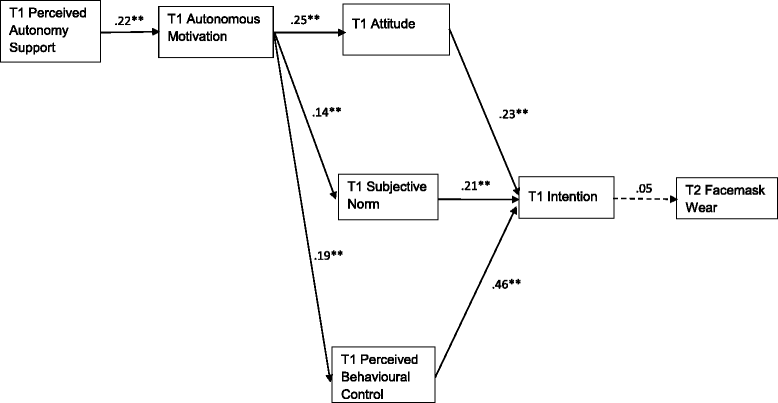The process by which perceived autonomy support predicts motivation, intention, and behavior for seasonal influenza prevention in Hong Kong older adults
- PMID: 28754156
- PMCID: PMC5534058
- DOI: 10.1186/s12889-017-4608-x
The process by which perceived autonomy support predicts motivation, intention, and behavior for seasonal influenza prevention in Hong Kong older adults
Erratum in
-
Erratum to: BMC Public Health, Vol. 18.BMC Public Health. 2017 Sep 22;17(1):736. doi: 10.1186/s12889-017-4709-6. BMC Public Health. 2017. PMID: 28938882 Free PMC article. No abstract available.
Abstract
Background: This study examined the effectiveness of a theoretical framework that integrates self-determination theory (SDT) and the theory of planned behavior (TPB) in explaining the use of facemasks to prevent seasonal influenza among Hong Kong older adults.
Methods: Data were collected at two time points in the winter in Hong Kong, during which influenza is most prevalent. At Time 1, older adults (N = 141) completed self-report measures of SDT (perceived autonomy support from senior center staff, autonomous motivation for influenza prevention) and TPB (attitude, subjective norm, perceived behavioral control, and intention for influenza prevention) constructs with respect to facemask used to prevent infection. Two weeks later, at Time 2, participants' acceptance of a facemask to prevent influenza in the presence of an experimenter with flu-like symptoms was recorded.
Results: Path analysis found that perceived autonomy support of senior center staff was positively and significantly linked to autonomous motivation for facemask use, which, in turn, was positively related to intentions to wear facemasks through the mediation of attitude, subjective norm, and perceived behavioral control. However, the effect of intention on facemask use was not significant.
Conclusions: Results generally support the proposed framework and the findings of previous studies with respect to intention, but the non-significant intention-behavior relationship may warrant future research to examine the reasons for older adults not to wear facemasks to prevent seasonal influenza despite having positive intentions to do so.
Keywords: Elderly; Facemask wearing; Infection; Infectious diseases; Self-determination theory; Theory of planned behavior.
Conflict of interest statement
Ethics approval and consent to participate
The current study involves human participants and the research protocol had been approved by the committee of Research Ethics and Safety (HASC) at Hong Kong Baptist University. All participants provided written informed consent to participate.
Consent for publication
Not applicable.
Competing interests
The authors declare that they have no competing interests.
Publisher’s Note
Springer Nature remains neutral with regard to jurisdictional claims in published maps and institutional affiliations.
Figures
References
-
- World Health Organization. Influenza (Seasonal). 2014. Retrieved from http://www.who.int/mediacentre/factsheets/fs211/en/.
-
- Harper SA, Bradley JS, Englund JA, File TM, Gravenstein S, Hayden FG, et al. Seasonal influenza in adults and children-diagnosis, treatment, chemoprophylaxis, and institutional outbreak management: clinical practice guidelines of the Infectious Diseases Society of America. Clin Infect Dis. 2009;48:1003–1032. doi: 10.1086/598513. - DOI - PMC - PubMed
-
- Süß T, Remschmidt C, Schink S, Luchtenberg M, Haas W, Krause G, Buchholz U. Facemasks and intensified hand hygiene in a German household trial during the 2009/2010 influenza a (H1N1) pandemic: adherence and tolerability in children and adults. Epidemiol Infect. 2011;139(12):1895–1901. doi: 10.1017/S0950268810003006. - DOI - PubMed
-
- World Health Organization. Advice on the use of masks in the community setting in Influenza A(H1N1) outbreaks. 2009. Retrieved from http://www.who.int/csr/resources/publications/Adviceusemaskscommunityrev...
MeSH terms
LinkOut - more resources
Full Text Sources
Other Literature Sources
Medical


